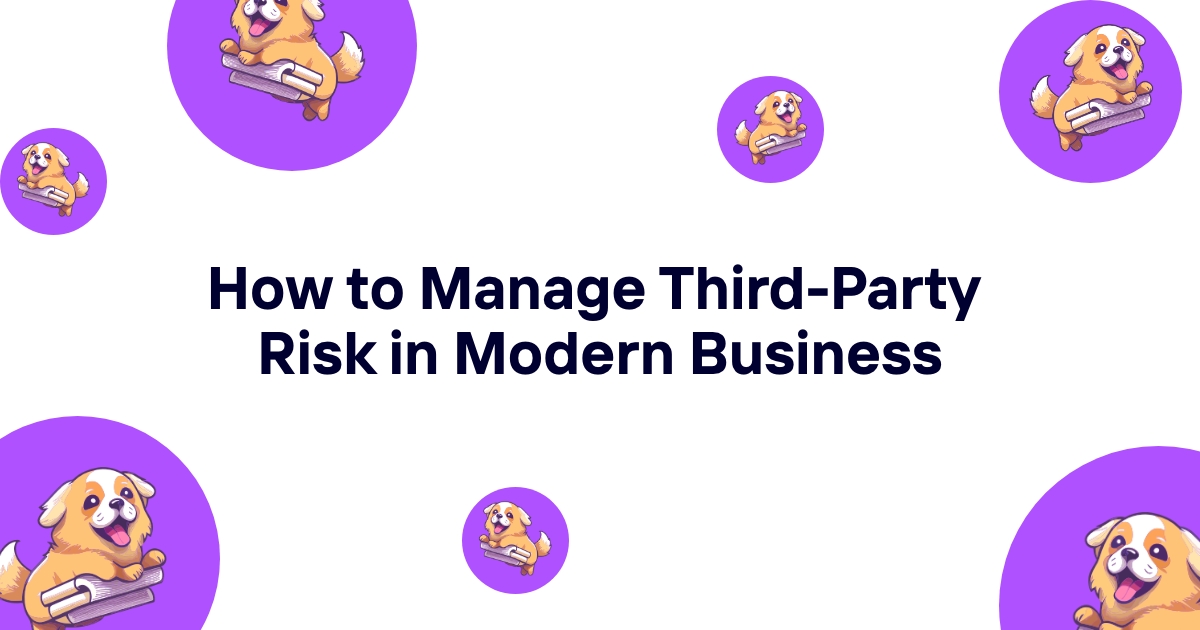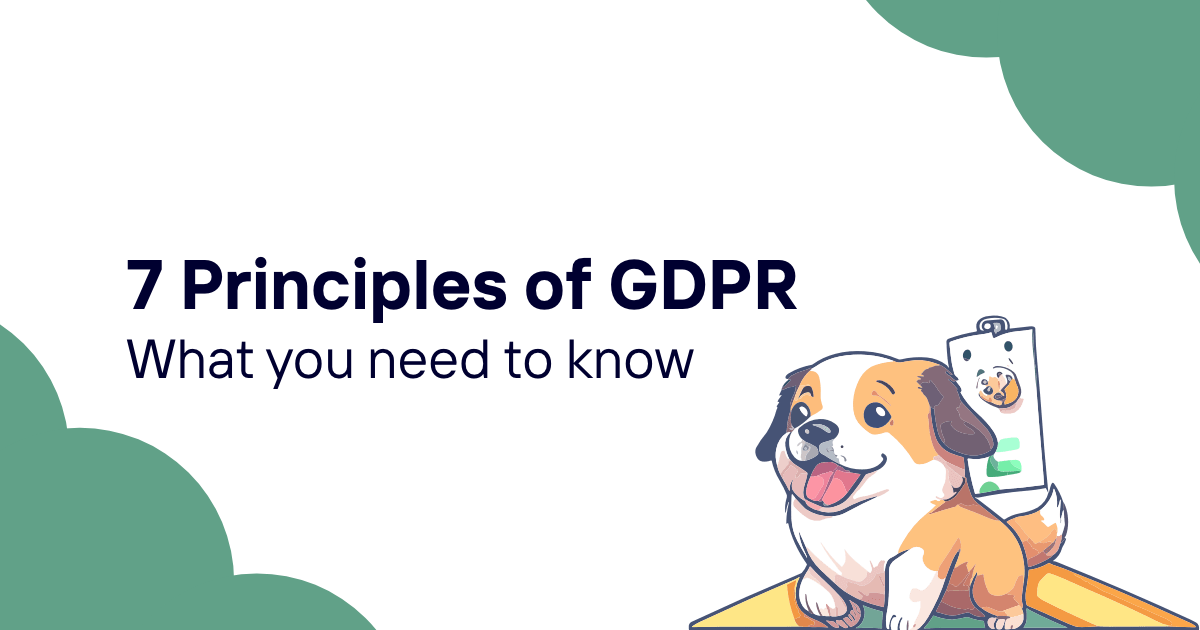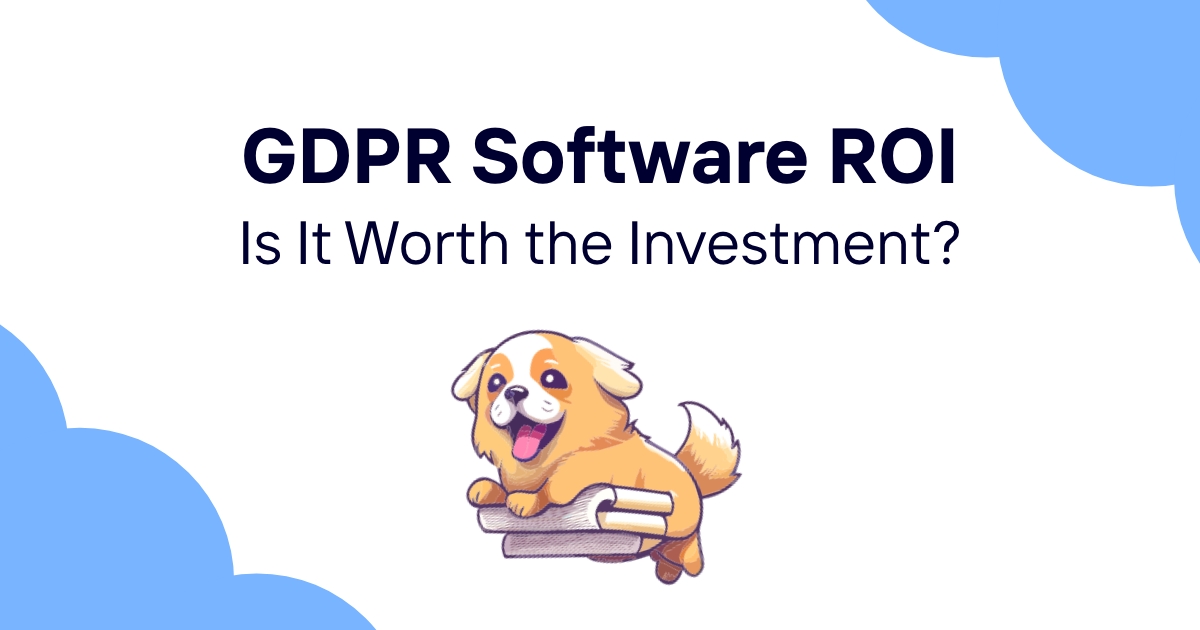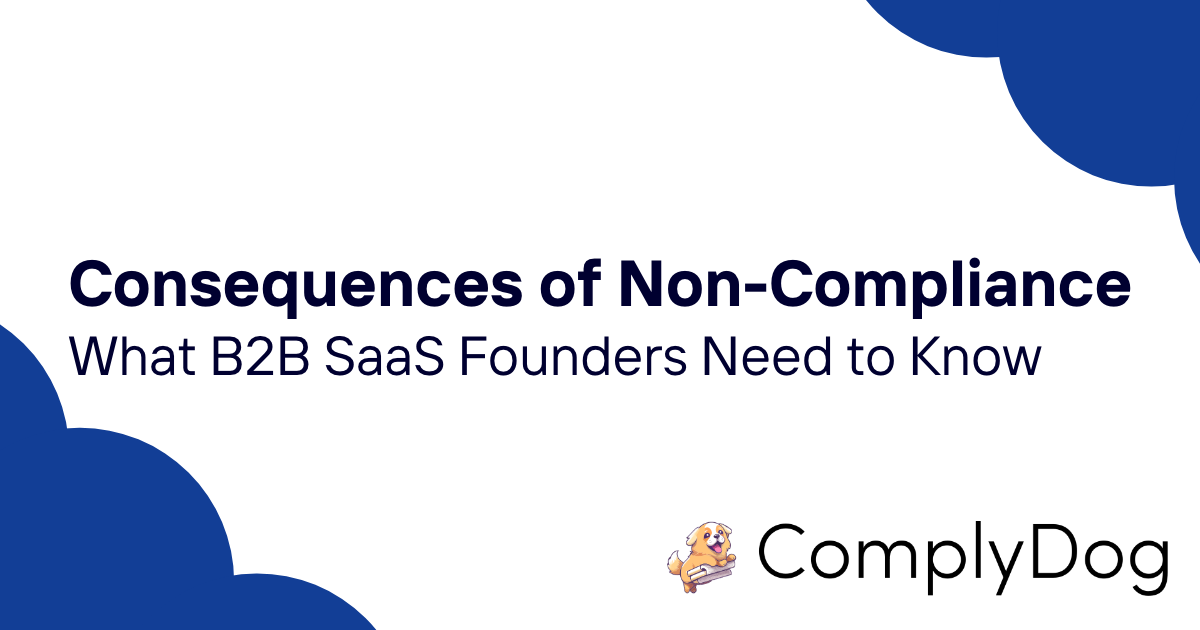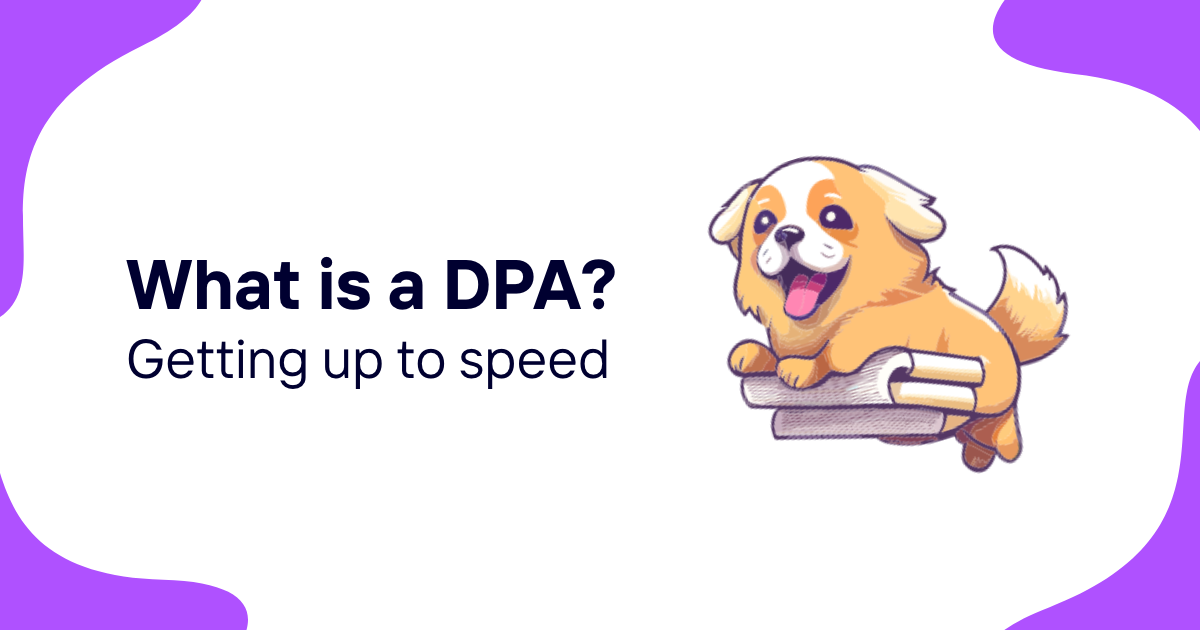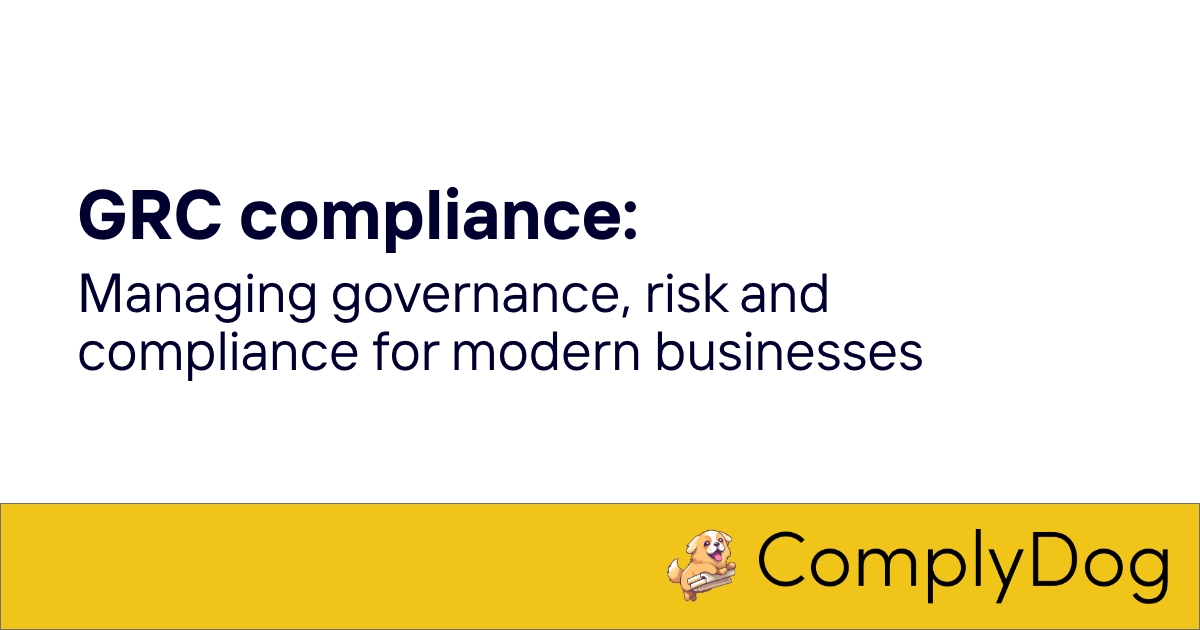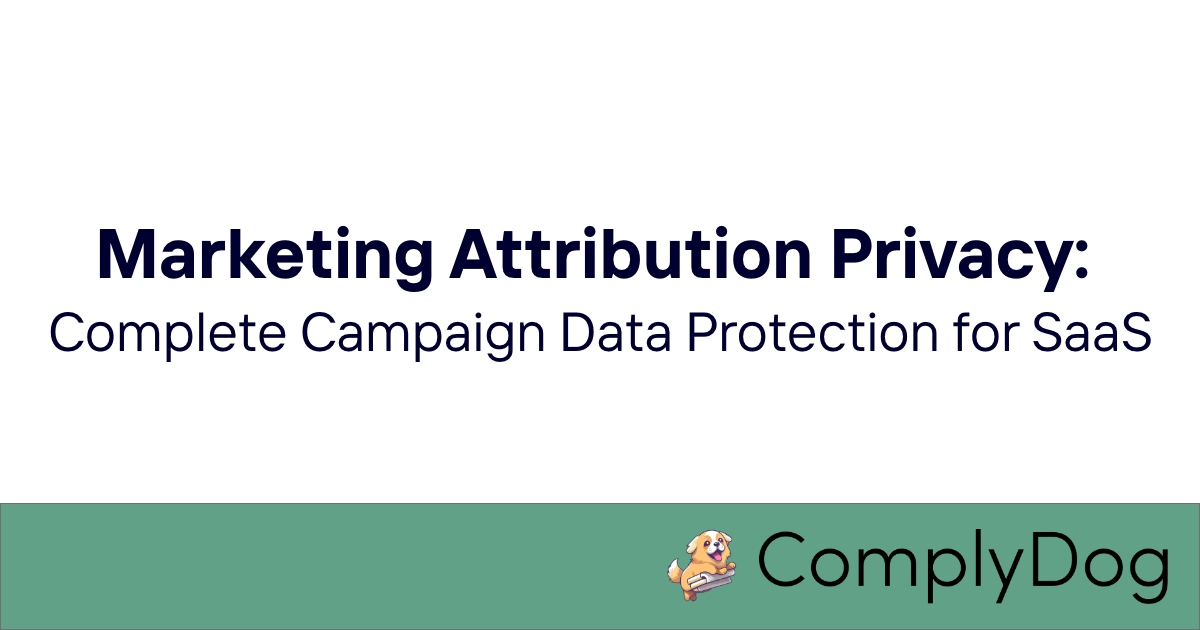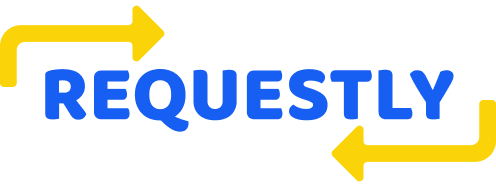Organizations today face an uncomfortable reality: success depends on partnerships with countless external vendors, suppliers, and service providers. Each relationship creates potential vulnerabilities that extend far beyond the company's direct control. The solution lies in implementing robust third-party risk management (TPRM) practices that protect business operations while enabling growth through strategic partnerships.
Third-party relationships have become the backbone of modern business operations. From cloud storage providers to logistics companies, marketing agencies to payment processors, organizations rely on external partners to function effectively. This interconnected web of relationships brings tremendous benefits but also introduces significant risks that require careful management.
Table of contents
- What is third-party risk management?
- Why third-party risk management matters
- Types of third-party risks
- The third-party risk management lifecycle
- Best practices for effective TPRM
- Who owns third-party risk management?
- Common TPRM challenges and solutions
- Building vendor relationships that last
- The role of technology in TPRM
- Measuring TPRM success
- Future trends in third-party risk management
What is third-party risk management?
Third-party risk management represents a systematic approach to identifying, assessing, and mitigating risks that arise from relationships with external vendors, suppliers, contractors, and service providers. The practice goes beyond simple vendor vetting. It encompasses the entire lifecycle of third-party relationships, from initial due diligence through ongoing monitoring and eventual contract termination.
At its core, TPRM recognizes that outsourcing business functions—while beneficial—transfers certain responsibilities to external entities that may not share the same risk tolerance, security standards, or operational priorities as the hiring organization. This misalignment creates potential exposure points that require active management.
The discipline encompasses various terms used interchangeably across industries: vendor risk management (VRM), supplier risk management, and supply chain risk management. While subtle differences exist between these approaches, they all focus on the same fundamental challenge: how to maintain control and visibility over risks introduced through external partnerships.
Modern TPRM programs address multiple risk categories simultaneously. Cybersecurity risks receive significant attention, but financial, operational, compliance, reputational, and strategic risks demand equal consideration. A comprehensive program evaluates vendors across all relevant risk dimensions while implementing controls proportionate to the level of risk each relationship presents.
The practice has evolved significantly as organizations have become more dependent on external providers. What started as basic vendor screening has grown into sophisticated risk assessment frameworks that leverage technology, standardized questionnaires, continuous monitoring tools, and automated workflow management systems.
Why third-party risk management matters
Business disruptions caused by third-party failures can devastate operations, damage reputations, and result in substantial financial losses. Recent years have highlighted the interconnected nature of modern business ecosystems, where a single vendor incident can cascade across multiple organizations and industries.
Data breaches at third-party providers often expose sensitive information belonging to multiple client organizations. When a vendor experiences a security incident, all connected companies face potential data exposure, regulatory scrutiny, and customer trust issues. The financial impact extends beyond immediate breach response costs to include regulatory fines, legal fees, and long-term reputational damage.
Operational dependencies create another layer of vulnerability. Organizations that rely heavily on specific vendors for critical functions face significant disruption when those providers experience outages, natural disasters, or business failures. The inability to quickly switch providers or maintain operations during vendor disruptions can result in lost revenue, missed deadlines, and customer dissatisfaction.
Regulatory compliance adds another dimension to third-party risk. Data protection regulations like GDPR hold organizations accountable for how their vendors handle personal information. Compliance frameworks in healthcare, finance, and other regulated industries impose strict requirements on third-party relationships. Failures by vendors to meet these standards can result in regulatory action against the hiring organization.
Financial risks manifest in multiple ways through third-party relationships. Vendor bankruptcy can disrupt operations and result in lost deposits or prepaid services. Cost overruns, scope creep, and performance failures can impact project budgets and timelines. Currency fluctuations, economic instability in vendor locations, and other financial factors can affect the cost and availability of third-party services.
The concentration of risk among a small number of large service providers compounds these challenges. When major cloud providers, logistics companies, or payment processors experience issues, the impact reaches across entire industries. Organizations must balance the benefits of working with established providers against the systemic risks created by industry consolidation.
Types of third-party risks
Third-party risks span multiple categories, each requiring different assessment approaches and mitigation strategies. Organizations must evaluate vendors across all relevant risk dimensions to develop comprehensive risk profiles.
Cybersecurity and information security risks
Cybersecurity risks represent the most visible and frequently discussed category of third-party risk. Vendors often require access to sensitive data, internal systems, and network infrastructure to deliver their services. This access creates potential entry points for cyberattacks and data breaches.
Common cybersecurity risks include inadequate access controls, weak authentication mechanisms, insufficient data encryption, poor incident response capabilities, and vulnerable software systems. Vendors may lack the security expertise, resources, or organizational commitment needed to maintain robust cybersecurity practices.
Data handling practices require careful evaluation. How vendors collect, store, process, and dispose of sensitive information directly impacts the hiring organization's security posture. Cross-border data transfers introduce additional complexity, particularly when vendors operate in jurisdictions with different privacy laws or government access requirements.
Operational and performance risks
Operational risks arise when vendors fail to deliver services according to agreed-upon standards, timelines, or performance metrics. These failures can disrupt business operations, delay projects, and impact customer satisfaction.
Service availability represents a critical operational risk. Vendors that experience frequent outages, capacity constraints, or performance degradation can significantly impact dependent business processes. The lack of adequate backup systems, disaster recovery capabilities, or business continuity planning compounds these risks.
Scalability limitations can create problems as business needs evolve. Vendors unable to accommodate growth, seasonal fluctuations, or changing requirements may become operational bottlenecks. Geographic limitations, resource constraints, or technological capabilities may restrict a vendor's ability to scale with client needs.
Quality control issues manifest in various ways depending on the service type. Manufacturing suppliers may deliver defective products. Software providers may release buggy applications. Service providers may deliver substandard work that requires costly corrections or delays project completion.
Financial and strategic risks
Financial risks encompass the vendor's financial stability, pricing practices, and economic factors that could impact service delivery. Vendors experiencing financial difficulties may reduce service quality, delay deliverables, or cease operations entirely.
Credit risk assessment becomes important when making advance payments, deposits, or long-term commitments to vendors. Organizations need to evaluate the vendor's financial statements, credit ratings, and overall financial health before entering into significant contractual arrangements.
Currency and economic risks affect relationships with international vendors. Exchange rate fluctuations can impact service costs over time. Economic instability, political changes, or regulatory shifts in vendor locations may affect service availability or pricing.
Strategic risks arise when vendor relationships create dependencies that limit future flexibility or competitive advantage. Exclusive arrangements, proprietary technologies, or unique expertise may create switching costs that reduce negotiating power or strategic options.
Compliance and regulatory risks
Compliance risks emerge when vendors fail to meet applicable regulatory requirements or industry standards. Organizations remain accountable for compliance even when using third-party providers, making vendor compliance capabilities a critical consideration.
Data protection regulations impose specific requirements on how personal information is collected, processed, and protected. Vendors that handle personal data must demonstrate compliance with applicable privacy laws, including GDPR, CCPA, and other regional data protection frameworks.
Industry-specific regulations create additional compliance requirements. Healthcare organizations must verify HIPAA compliance. Financial services companies must evaluate vendors against banking regulations. Government contractors must meet specific security and clearance requirements.
International compliance adds complexity when working with global vendors. Different jurisdictions may have conflicting requirements or restrictions that affect service delivery. Export controls, sanctions, and other trade regulations may limit vendor options or create ongoing compliance obligations.
The third-party risk management lifecycle
Effective TPRM follows a structured lifecycle approach that begins before vendor selection and continues throughout the entire relationship. This lifecycle ensures consistent risk evaluation and ongoing risk management across all third-party relationships.
Phase 1: Vendor identification and inventory
The TPRM lifecycle begins with comprehensive vendor identification and inventory development. Organizations must first understand the full scope of their third-party relationships before implementing risk management processes.
Vendor discovery involves collecting information from multiple sources within the organization. Different departments may have relationships with vendors that are unknown to central procurement or risk management teams. Accounts payable records, contract management systems, and IT asset databases can help identify active vendor relationships.
Business unit interviews and surveys help uncover shadow IT arrangements, informal service agreements, and relationships that may not appear in formal procurement systems. Marketing teams may work with agencies, HR departments may use recruiting firms, and individual business units may have subscriptions to software services.
Vendor classification follows discovery activities. Not all vendors present the same level of risk or require the same management approach. Organizations typically categorize vendors based on factors like criticality to operations, access to sensitive data, regulatory requirements, and contract value.
Risk-based tiering helps prioritize vendor management efforts. High-risk, high-impact vendors receive more intensive due diligence and ongoing monitoring. Lower-risk relationships may require only basic vetting and periodic reviews.
Phase 2: Due diligence and risk assessment
Due diligence represents the foundation of effective third-party risk management. This phase involves comprehensive evaluation of potential vendors before contract execution and ongoing assessment of existing relationships.
Initial vendor evaluation typically includes financial stability assessment, operational capability review, security posture evaluation, and compliance verification. Organizations use various tools including questionnaires, on-site assessments, third-party reports, and reference checks to gather necessary information.
Security assessments focus on the vendor's cybersecurity practices, data protection capabilities, and information security governance. Standard frameworks like SOC 2, ISO 27001, and industry-specific standards provide benchmarks for evaluation.
Financial due diligence examines the vendor's financial health, business model sustainability, and long-term viability. Credit reports, financial statements, and business references help assess financial risks.
Operational assessment evaluates the vendor's ability to deliver services according to requirements. This includes capacity evaluation, quality management systems, business continuity planning, and service delivery track record.
Phase 3: Contract negotiation and onboarding
Contract terms play a crucial role in managing third-party risks. Well-structured agreements allocate responsibilities, define performance standards, and establish mechanisms for ongoing risk management.
Risk allocation clauses specify which party bears responsibility for different types of incidents or failures. Liability limitations, indemnification provisions, and insurance requirements help protect against financial exposure.
Performance standards and service level agreements (SLAs) establish measurable criteria for vendor performance. These metrics provide the basis for ongoing performance monitoring and remediation when standards are not met.
Data protection and security provisions address how sensitive information will be handled throughout the relationship. These clauses should specify data handling requirements, security standards, incident notification procedures, and audit rights.
Termination and transition planning provisions help manage the end of vendor relationships. Clear termination procedures, data return requirements, and transition assistance obligations facilitate smooth transitions when relationships end.
Phase 4: Ongoing monitoring and management
Active monitoring throughout the vendor relationship lifecycle helps identify emerging risks and performance issues before they impact business operations.
Performance monitoring tracks vendor delivery against established SLAs and performance metrics. Regular reporting, review meetings, and performance scorecards provide visibility into vendor performance trends.
Risk monitoring involves ongoing assessment of factors that could affect vendor risk profiles. This includes financial monitoring, security incident tracking, regulatory changes, and business environment shifts that could impact vendor capabilities.
Relationship management activities include regular business reviews, strategic planning discussions, and issue resolution processes. Strong vendor relationships facilitate better communication and more effective problem resolution.
Compliance monitoring verifies ongoing adherence to contractual requirements, regulatory standards, and industry best practices. Regular audits, assessments, and certifications help maintain compliance over time.
Phase 5: Performance review and optimization
Regular performance reviews provide opportunities to assess vendor relationships holistically and identify optimization opportunities.
Comprehensive performance evaluation examines vendor performance across multiple dimensions including service quality, cost effectiveness, risk management, and strategic value. These reviews inform decisions about contract renewals, relationship expansion, or termination.
Cost optimization activities identify opportunities to improve value from vendor relationships. This may include contract renegotiation, service level adjustments, or alternative service delivery models.
Risk mitigation planning addresses identified weaknesses or emerging risks in vendor relationships. Remediation plans, additional controls, or relationship restructuring may be necessary to maintain acceptable risk levels.
Strategic alignment assessment evaluates how well vendor relationships support overall business objectives and strategy. Changes in business direction, technology strategy, or market conditions may require adjustments to vendor portfolios.
Phase 6: Offboarding and transition
Vendor relationship termination requires careful planning to protect business operations and sensitive information.
Transition planning begins well before contract expiration or termination. Organizations need to identify alternative service providers, develop migration plans, and prepare for potential service disruptions during transitions.
Data and asset return procedures ensure that sensitive information and company assets are properly returned or securely destroyed. Clear documentation of data locations, formats, and destruction methods protects against data exposure.
Knowledge transfer activities capture important information about service delivery, configurations, and operational procedures before vendor relationships end. This knowledge helps maintain service continuity and facilitates transitions to new providers.
Final performance evaluation and lessons learned capture insights that inform future vendor selection and management decisions.
Best practices for effective TPRM
Successful TPRM programs incorporate proven practices that maximize effectiveness while minimizing administrative burden. These practices help organizations build resilient vendor ecosystems that support business objectives.
Establish clear governance and accountability
Effective TPRM requires clear organizational structure and accountability. Organizations need designated ownership for vendor risk management activities and clear escalation procedures for risk issues.
Executive sponsorship provides the authority and resources needed for effective TPRM implementation. Senior leadership involvement demonstrates organizational commitment and facilitates cross-functional cooperation.
Defined roles and responsibilities prevent gaps in vendor oversight and avoid duplicated efforts. Clear assignment of accountability for different aspects of vendor management helps maintain consistent practices.
Regular reporting to senior management and board oversight committees maintains visibility into vendor risk exposures and management effectiveness. Standardized reporting metrics help track program performance over time.
Implement risk-based vendor segmentation
Not all vendors require the same level of management intensity. Risk-based segmentation helps organizations focus resources on relationships that present the greatest risk or business impact.
Criticality assessment evaluates how important each vendor is to business operations. Critical vendors that could cause significant operational disruption if they fail require more intensive management.
Risk exposure assessment examines the potential impact if vendor-related risks materialize. High-risk vendors with access to sensitive data or critical systems need enhanced oversight.
Tiered management approaches align oversight activities with risk and criticality levels. High-tier vendors may require extensive due diligence, regular assessments, and continuous monitoring. Lower-tier vendors may need only basic vetting and periodic reviews.
Standardize assessment processes
Consistent assessment processes improve efficiency and ensure comprehensive risk evaluation across all vendor relationships.
Standardized questionnaires and evaluation criteria facilitate comparison between vendors and maintain consistency in risk assessment quality. Industry-standard frameworks like SIG, CAIQ, and HECVAT provide proven assessment templates.
Automated workflow systems help manage assessment processes, track completion status, and maintain documentation. These systems improve efficiency and provide audit trails for compliance purposes.
Assessment templates tailored to different vendor types or risk categories ensure that evaluations address relevant risk factors. IT service providers, manufacturing suppliers, and professional service firms may require different assessment approaches.
Leverage technology for efficiency and insight
Technology solutions can significantly improve TPRM efficiency and effectiveness by automating routine tasks and providing better risk visibility.
Risk assessment platforms automate questionnaire distribution, response collection, and risk scoring. These systems can integrate with external data sources to supplement vendor-provided information with independent risk intelligence.
Continuous monitoring tools track vendor risk indicators in real time. Credit monitoring, cybersecurity ratings, news monitoring, and regulatory databases provide ongoing visibility into changing risk conditions.
Contract management systems centralize vendor agreements, track key terms and obligations, and provide alerts for important dates and milestones.
Integration capabilities connect TPRM systems with other business applications to share data and automate workflows. Integration with procurement, accounts payable, and asset management systems provides comprehensive vendor visibility.
Focus on continuous improvement
TPRM programs require ongoing refinement and optimization to remain effective as business needs and risk environments evolve.
Regular program assessment identifies opportunities to improve processes, tools, and outcomes. Metrics tracking, stakeholder feedback, and benchmarking against industry practices inform improvement priorities.
Training and awareness programs help staff understand their roles in vendor risk management and stay current with evolving practices and requirements.
Industry participation through professional associations, conferences, and peer networks provides access to best practices and emerging trends.
Lessons learned from vendor incidents, assessment findings, and operational challenges inform program improvements and help prevent similar issues in the future.
Who owns third-party risk management?
TPRM ownership varies significantly across organizations based on size, industry, regulatory requirements, and organizational structure. The distributed nature of vendor relationships often requires coordination among multiple departments and functions.
Common organizational models
Many organizations assign TPRM ownership to procurement departments that already manage vendor relationships and contracts. This approach leverages existing vendor management expertise and established relationship channels.
Information security teams often lead TPRM programs due to their focus on cybersecurity risks and technical assessment capabilities. This model works well when security risks represent the primary concern, but may not address operational or financial risks comprehensively.
Risk management departments provide natural homes for TPRM programs due to their enterprise risk perspective and experience with risk assessment methodologies. These teams can coordinate vendor risk management with other enterprise risk activities.
Legal and compliance teams sometimes own TPRM programs, particularly in highly regulated industries where compliance requirements drive vendor management activities. This approach ensures regulatory alignment but may lack operational focus.
Cross-functional collaboration requirements
Regardless of organizational ownership, successful TPRM requires collaboration among multiple functions that have vendor relationships or relevant expertise.
Procurement teams manage vendor selection, contract negotiation, and relationship management activities. Their involvement ensures that risk considerations are incorporated into commercial decisions.
Information security teams assess cybersecurity risks, define technical requirements, and monitor security performance. Their expertise is critical for evaluating technology vendors and data handling practices.
Legal teams review contracts, assess liability implications, and ensure regulatory compliance. Their involvement helps incorporate risk management requirements into enforceable agreements.
Business units that use vendor services provide requirements definition, performance feedback, and operational insight. Their participation ensures that risk management activities align with business needs.
Finance teams assess financial risks, approve expenditures, and monitor vendor financial performance. Their involvement helps evaluate vendor financial stability and cost implications.
Evolving role definitions
TPRM roles continue to evolve as organizations recognize the strategic importance of vendor risk management and the need for specialized expertise.
Dedicated TPRM managers or teams are becoming more common in larger organizations with extensive vendor ecosystems. These specialists focus exclusively on vendor risk management and coordinate activities across multiple functions.
Chief Information Security Officers (CISOs) increasingly include vendor risk management in their responsibilities as cybersecurity risks from third parties receive greater attention.
Chief Risk Officers (CROs) often oversee TPRM as part of enterprise risk management programs, particularly in industries where vendor risks represent significant business exposures.
Vendor relationship managers focus on strategic vendor partnerships and may include risk management in their responsibilities for high-value or critical vendor relationships.
Common TPRM challenges and solutions
Organizations implementing TPRM programs encounter predictable challenges that can impede effectiveness if not addressed proactively. Understanding these challenges and proven solutions helps organizations avoid common pitfalls.
Resource and capacity constraints
Limited resources represent the most common TPRM implementation challenge. Organizations often lack sufficient staff, budget, or expertise to implement comprehensive vendor risk management programs.
Solution approaches:
Phased implementation focuses initial efforts on highest-risk vendors while gradually expanding program scope. This approach allows organizations to build capabilities and demonstrate value before requesting additional resources.
Risk-based prioritization concentrates resources on vendors that present the greatest risk exposure. Automated tools and streamlined processes help manage lower-risk vendors with minimal resource investment.
Shared resources across multiple functions can provide cost-effective TPRM capabilities. Risk management, procurement, and security teams can share assessment tools, vendor data, and expertise to maximize efficiency.
Outsourced services can supplement internal capabilities for specialized tasks like vendor assessments, security reviews, or ongoing monitoring activities.
Vendor assessment fatigue
Vendors often receive multiple questionnaires and assessment requests from different clients, leading to assessment fatigue and reduced cooperation with TPRM activities.
Solution approaches:
Industry-standard assessment formats reduce vendor burden by allowing reuse of assessment responses across multiple clients. Shared Assessments SIG, CSA CAIQ, and other standard frameworks facilitate this approach.
Assessment sharing programs allow vendors to complete assessments once and share results with multiple clients. Third-party platforms facilitate secure assessment sharing while protecting sensitive information.
Streamlined assessment processes focus on material risks and eliminate unnecessary questions. Right-sized assessments based on vendor risk and criticality levels improve vendor cooperation.
Collaborative assessment approaches involve multiple organizations assessing shared vendors jointly, reducing duplication and vendor burden.
Lack of vendor transparency
Vendors may be reluctant to share detailed information about their operations, security practices, or risk management capabilities, limiting the effectiveness of risk assessments.
Solution approaches:
Clear contractual requirements establish vendor obligations to provide necessary information for risk management purposes. Contracts should specify required disclosures, assessment participation, and audit rights.
Incentive alignment demonstrates how risk management activities benefit vendors through reduced insurance costs, competitive advantages, or preferred vendor status.
Independent verification supplements vendor-provided information with third-party assessments, certifications, and external data sources.
Relationship building and trust development encourage vendors to share information by demonstrating how risk management supports mutual success rather than imposing additional burdens.
Inconsistent risk standards
Different business units, regions, or functions may apply inconsistent risk standards and assessment criteria, leading to uneven vendor risk management practices.
Solution approaches:
Centralized policies and procedures establish consistent risk standards and assessment criteria across the organization. Clear documentation and training ensure consistent application.
Standardized tools and platforms enforce consistent assessment processes and risk scoring methodologies. Technology solutions can embed risk standards into automated workflows.
Regular calibration exercises align risk assessments across different teams and ensure consistent interpretation of risk criteria and standards.
Centers of excellence provide subject matter expertise and support for business units implementing vendor risk management activities.
Integration with existing systems
TPRM activities often require integration with multiple existing systems including procurement, contract management, asset management, and security tools.
Solution approaches:
API-based integration connects TPRM platforms with existing business systems to share data and automate workflows. Modern platforms provide pre-built integrations with common business applications.
Data standardization initiatives establish consistent data formats and definitions across systems to facilitate integration and reporting.
Phased integration approaches begin with manual processes and gradually automate connections between systems as capabilities mature.
Vendor selection criteria should include integration capabilities to ensure that TPRM tools can connect with existing technology infrastructure.
Building vendor relationships that last
Effective TPRM goes beyond risk mitigation to enable strong, productive vendor relationships that create mutual value. The best programs balance risk management with relationship development to achieve long-term success.
Partnership mindset
Organizations that approach TPRM as partnership enablement rather than risk policing tend to achieve better outcomes with vendor cooperation and relationship quality.
Collaborative risk management involves vendors as partners in identifying and mitigating risks rather than subjects of risk assessment. This approach encourages vendors to proactively share risk information and work jointly on risk mitigation.
Shared value creation focuses on how effective risk management can benefit both parties through improved security, operational efficiency, and competitive positioning.
Trust building activities demonstrate organizational commitment to vendor success while maintaining appropriate risk standards. Fair contract terms, prompt payment, and reasonable risk requirements help build vendor trust and cooperation.
Long-term perspective balances short-term risk mitigation with relationship sustainability and strategic value creation.
Performance-based management
Moving beyond compliance-focused assessment to performance-based management helps create vendor relationships that drive continuous improvement and value creation.
Service level agreements (SLAs) establish clear performance expectations and provide frameworks for ongoing performance measurement and improvement.
Performance scorecards provide regular feedback to vendors on their performance across multiple dimensions including service quality, risk management, and relationship factors.
Continuous improvement programs encourage vendors to enhance their capabilities and address performance gaps through collaborative improvement initiatives.
Recognition and incentive programs reward superior vendor performance and risk management practices, encouraging other vendors to improve their capabilities.
Communication and transparency
Open communication channels and transparent expectations help build vendor relationships based on mutual understanding and shared objectives.
Regular business reviews provide forums for discussing performance, addressing issues, and planning future activities. These meetings should address risk management topics alongside operational and strategic discussions.
Clear expectations regarding risk management requirements, assessment processes, and performance standards help vendors understand their obligations and plan accordingly.
Feedback mechanisms allow vendors to provide input on risk management processes and suggest improvements that benefit both parties.
Issue escalation procedures provide clear paths for addressing problems quickly before they impact business operations or relationship quality.
Strategic vendor development
Organizations increasingly view key vendors as strategic assets that require development and investment rather than just cost centers to be managed.
Capability development programs help strategic vendors enhance their capabilities in areas important to the relationship such as security, quality, or innovation.
Joint planning activities align vendor development with organizational strategic objectives and create shared value opportunities.
Investment in vendor relationships through training, technology sharing, or collaborative projects can strengthen capabilities and relationship resilience.
Strategic vendor reviews evaluate relationship performance holistically and identify opportunities for expanded collaboration or capability development.
The role of technology in TPRM
Technology plays an increasingly important role in enabling effective and efficient TPRM programs. The right technology solutions can automate routine tasks, improve risk visibility, and provide better insights for decision-making.
Platform capabilities
Modern TPRM platforms provide comprehensive functionality that addresses the full vendor risk management lifecycle from initial assessment through ongoing monitoring and relationship management.
Vendor inventory management centralizes information about all third-party relationships and provides a single source of truth for vendor data. Advanced platforms can integrate with procurement, accounts payable, and other systems to automatically identify vendor relationships.
Risk assessment automation streamlines questionnaire distribution, response collection, and risk scoring processes. These systems can apply consistent scoring methodologies and provide comparative risk analysis across vendor portfolios.
Workflow management capabilities automate approval processes, task assignments, and follow-up activities. These features help ensure that risk management activities are completed timely and consistently.
Document management functions provide secure storage for vendor assessments, contracts, certifications, and other important documents. Version control and access management features protect sensitive information while enabling necessary sharing.
Integration and data sharing
Effective TPRM platforms integrate with other business systems to provide comprehensive visibility into vendor relationships and risks.
Procurement system integration shares vendor information, contract details, and purchase history to provide complete vendor relationship context.
Security tool integration combines TPRM data with security monitoring, incident management, and vulnerability assessment information to provide comprehensive security risk visibility.
Financial system integration provides accounts payable data, payment history, and financial performance information that supports vendor risk assessment and monitoring.
Contract management integration shares contract terms, obligations, and key dates that inform risk management activities and compliance monitoring.
Artificial intelligence and automation
AI and machine learning technologies increasingly support TPRM activities by automating routine tasks and providing advanced analytics capabilities.
Natural language processing helps analyze vendor documentation, contracts, and assessment responses to identify risk indicators and extract key information automatically.
Predictive analytics identify vendors at elevated risk of failure, security incidents, or performance problems based on historical data and risk indicators.
Risk scoring automation applies consistent scoring methodologies to vendor assessments and can incorporate external data sources to supplement vendor-provided information.
Workflow optimization uses AI to streamline approval processes, task routing, and resource allocation based on risk levels and organizational priorities.
External data integration
Modern TPRM platforms can integrate external data sources to provide additional context and validation for vendor risk assessments.
Credit monitoring services provide ongoing visibility into vendor financial health and alert organizations to significant financial changes.
Cybersecurity ratings services offer independent assessments of vendor security postures based on external scanning and analysis.
News and regulatory monitoring track vendor-related news, regulatory actions, and other events that could affect risk profiles.
Industry databases provide benchmarking data, peer comparisons, and industry-specific risk intelligence that inform vendor assessment and selection decisions.
Measuring TPRM success
Effective TPRM programs require measurement frameworks that track both risk mitigation effectiveness and operational efficiency. Well-designed metrics provide visibility into program performance and support continuous improvement efforts.
Risk reduction metrics
Primary TPRM metrics focus on risk reduction outcomes and the program's effectiveness in preventing vendor-related incidents and exposures.
Vendor incident rates track the frequency and severity of vendor-related security incidents, service disruptions, compliance violations, and other risk events. Declining incident rates indicate improving risk management effectiveness.
Risk assessment coverage measures the percentage of vendors that have completed appropriate risk assessments based on their risk tier and criticality level.
Control implementation rates track the deployment of risk mitigation controls and remediation activities across vendor relationships.
Time to resolution metrics measure how quickly vendor risk issues are identified, escalated, and resolved.
Operational efficiency metrics
Operational metrics track the efficiency and effectiveness of TPRM processes and activities.
Assessment cycle times measure how long vendor risk assessments take from initiation to completion. Decreasing cycle times indicate process improvements and increased efficiency.
Vendor onboarding speed tracks how quickly new vendors can be assessed and approved for use. Faster onboarding while maintaining risk standards indicates process optimization.
Cost per assessment and cost per vendor provide efficiency measures that help optimize resource allocation and identify opportunities for process improvement.
Automation rates track the percentage of TPRM activities that are automated versus manual, indicating program maturity and efficiency gains.
Business impact metrics
Business impact metrics connect TPRM activities to broader organizational objectives and demonstrate program value.
Vendor performance improvement tracks enhancements in vendor service quality, security postures, and compliance capabilities that result from TPRM activities.
Cost avoidance measures quantify potential losses prevented through effective risk management, including avoided incidents, improved contract terms, and better vendor selection.
Compliance success rates track the organization's ability to meet regulatory requirements and pass audits related to vendor risk management.
Stakeholder satisfaction measures assess how well the TPRM program meets the needs of business units, procurement teams, and other internal customers.
Leading and lagging indicators
Effective measurement frameworks include both leading indicators that predict future performance and lagging indicators that measure historical outcomes.
Leading indicators include assessment completion rates, control implementation status, vendor cooperation levels, and risk trend analysis.
Lagging indicators include incident rates, audit findings, regulatory violations, and actual losses from vendor-related risk events.
Balanced scorecards combine multiple metric types to provide comprehensive visibility into program performance and identify areas requiring attention.
Trend analysis tracks metrics over time to identify patterns, seasonal variations, and long-term improvement or deterioration in program effectiveness.
Future trends in third-party risk management
TPRM continues evolving as technology advances, risk environments change, and business models become increasingly dependent on external partnerships. Understanding emerging trends helps organizations prepare for future challenges and opportunities.
Increased regulatory focus
Regulatory attention on third-party risk management continues increasing across industries and jurisdictions. New regulations and guidance documents emphasize organizational accountability for vendor risks.
Supply chain security regulations address cybersecurity risks throughout vendor ecosystems and may require specific risk management practices, incident reporting, and supply chain transparency.
Data protection regulations increasingly hold organizations accountable for vendor data handling practices and require specific controls for third-party data processing arrangements.
Financial services regulations emphasize third-party risk management as a key component of operational risk frameworks and may require specific governance, assessment, and monitoring practices.
Technology advancement
Emerging technologies continue transforming TPRM capabilities and creating new approaches to vendor risk management.
Artificial intelligence and machine learning enable more sophisticated risk analysis, predictive modeling, and automated decision-making in vendor risk management.
Blockchain technologies may provide new approaches to vendor credentialing, assessment sharing, and supply chain transparency.
Internet of Things (IoT) devices create new categories of vendor relationships and risk exposures that require specialized assessment and monitoring approaches.
Cloud computing continues shifting vendor relationships toward service-based models that require new risk assessment and management approaches.
Risk environment evolution
The risk environment continues evolving with new threat types, attack vectors, and vulnerability categories that affect vendor relationships.
Nation-state cyber threats increasingly target supply chains and third-party relationships as attack vectors against ultimate targets.
Climate change and extreme weather events create new categories of operational risk that affect vendor facilities, supply chains, and service delivery capabilities.
Geopolitical tensions affect international vendor relationships through trade restrictions, sanctions, and national security considerations.
Economic volatility creates financial risks for vendors and may affect service availability, pricing, and relationship stability.
Business model changes
Evolving business models create new patterns of vendor dependency and risk exposure that require adapted TPRM approaches.
Digital transformation initiatives increase organizational dependence on technology vendors and create new categories of operational risk.
Remote work models expand the vendor ecosystem to include new categories of service providers and create new risk management challenges.
Ecosystem business models create complex webs of interdependent vendor relationships that require sophisticated risk management approaches.
Sustainability requirements add environmental and social risk dimensions to vendor assessment and selection processes.
The complexity of modern vendor ecosystems will likely require more sophisticated TPRM approaches that can handle multiple risk types, dynamic relationship patterns, and evolving business requirements. Organizations that invest in mature TPRM capabilities will be better positioned to thrive in increasingly interconnected business environments.
Managing third-party relationships effectively requires a systematic approach that balances risk mitigation with business enablement. Organizations that implement comprehensive TPRM programs can leverage external partnerships while protecting against the inherent risks of vendor dependencies. The key lies in developing mature processes, leveraging appropriate technologies, and maintaining focus on both risk management and relationship development.
For software businesses navigating the complex landscape of vendor relationships, compliance platforms like ComplyDog provide integrated solutions that streamline TPRM activities while ensuring adherence to regulatory requirements. By automating risk assessments, centralizing vendor documentation, and providing continuous monitoring capabilities, ComplyDog helps organizations build resilient vendor ecosystems that support growth while maintaining appropriate risk controls. The platform's comprehensive approach to compliance management enables companies to manage third-party risks as part of broader regulatory and operational risk frameworks, creating more efficient and effective risk management programs.
